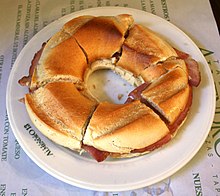


Rosca from Madrid, Spain
| |
| Alternative names | Ka'ake |
|---|---|
| Type | Bread, bagel, doughnut |
| Region or state | Mexico, South America, and other areas |
| Created by | Spanish and Portuguese |
| Main ingredients | Flour, salt, sugar, butter, yeast, water, and seasonings |
Rosca (ring or bagel) is a Spanish and Portuguese[1] bread dish eaten in Spain, Mexico, South America, and other areas. It is made with flour, salt, sugar, butter, yeast, water, and seasonings. It is also called ka'ake and referred to as a "Syrian-style cracker ring".[2]
Roscas de reyes (ring of kings or three King's bread) is eaten on "El Dia de Los Reyes" ("The Day of the Kings"), which is part of the celebration of the Three Kings visiting the infant Jesus to give him gifts (traditionally gold, myrrh, and incense).[3]
The cake itself is an oversized version of kingcake colored with candy fruit. Raisins, milk, anise, cinnamon, vanilla, and colorful candy fruit are used depending on the recipe.[4][5]
At least one plastic miniature figurine of the baby Jesus can be hidden inside the cake. The person who finds it is seen as the lucky winner of the prize (whatever that might be).[5] In many traditions, the person who finds a plastic baby first must host a dinner party, and anyone who finds another plastic baby must bring a dish. The dinner party is hosted on 2 February, which is called "Dia de la Virgen de la Candelaria" ("Day of the Virgin of Candelaria"). After eating the rosca, the children leave their shoes near the doorstep so they can receive a small gift.[citation needed]
|
| |||||||||||
|---|---|---|---|---|---|---|---|---|---|---|---|
| Soups and stews |
|

| |||||||||
| Rice dishes |
| ||||||||||
| Bean dishes |
| ||||||||||
| Egg dishes |
| ||||||||||
| Vegetable dishes |
| ||||||||||
| Meat dishes |
| ||||||||||
| Other protein dishes |
| ||||||||||
| Cheese dishes |
| ||||||||||
| Antojitos |
| ||||||||||
| Sauces and condiments |
| ||||||||||
| Desserts and sweets |
| ||||||||||
| Salads |
| ||||||||||
| Breads |
| ||||||||||
| Beverages |
| ||||||||||
| Variants |
| ||||||||||
| |||||||||||
| |||||||||||